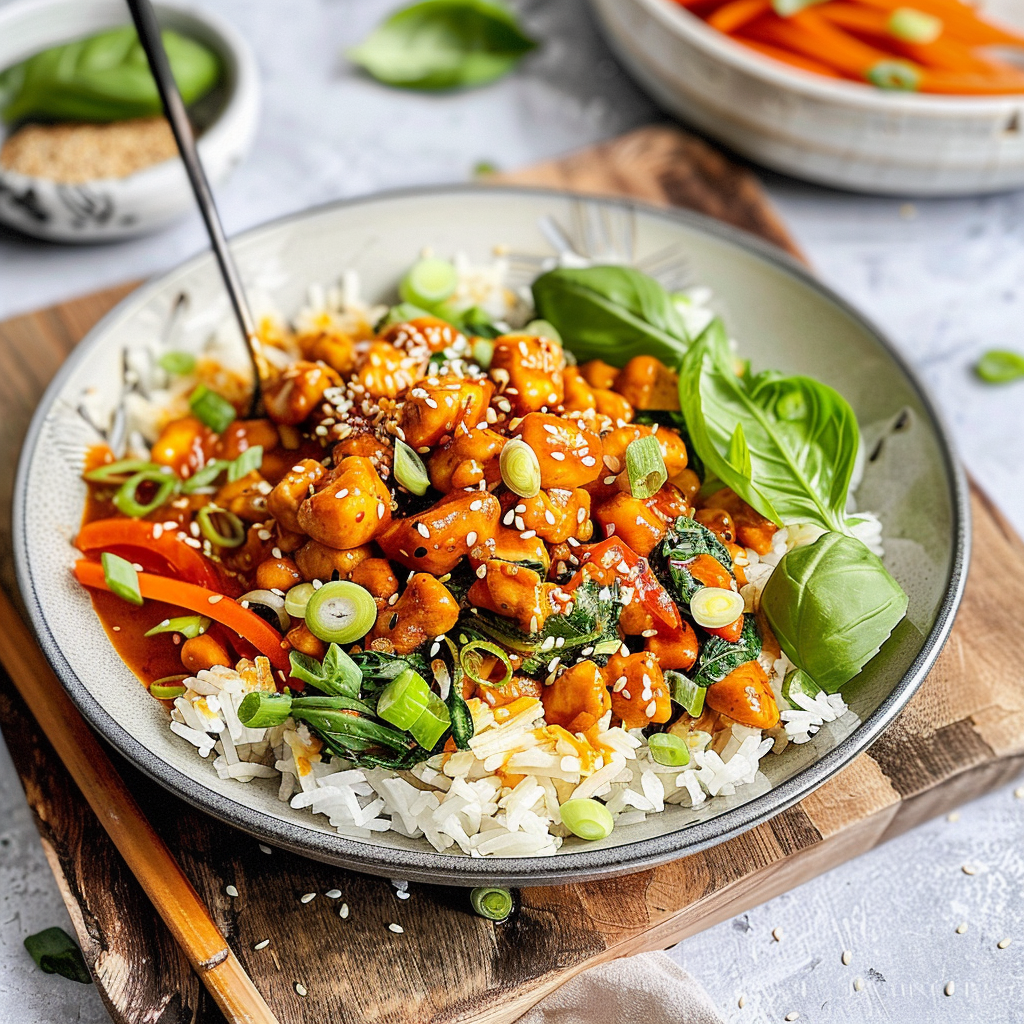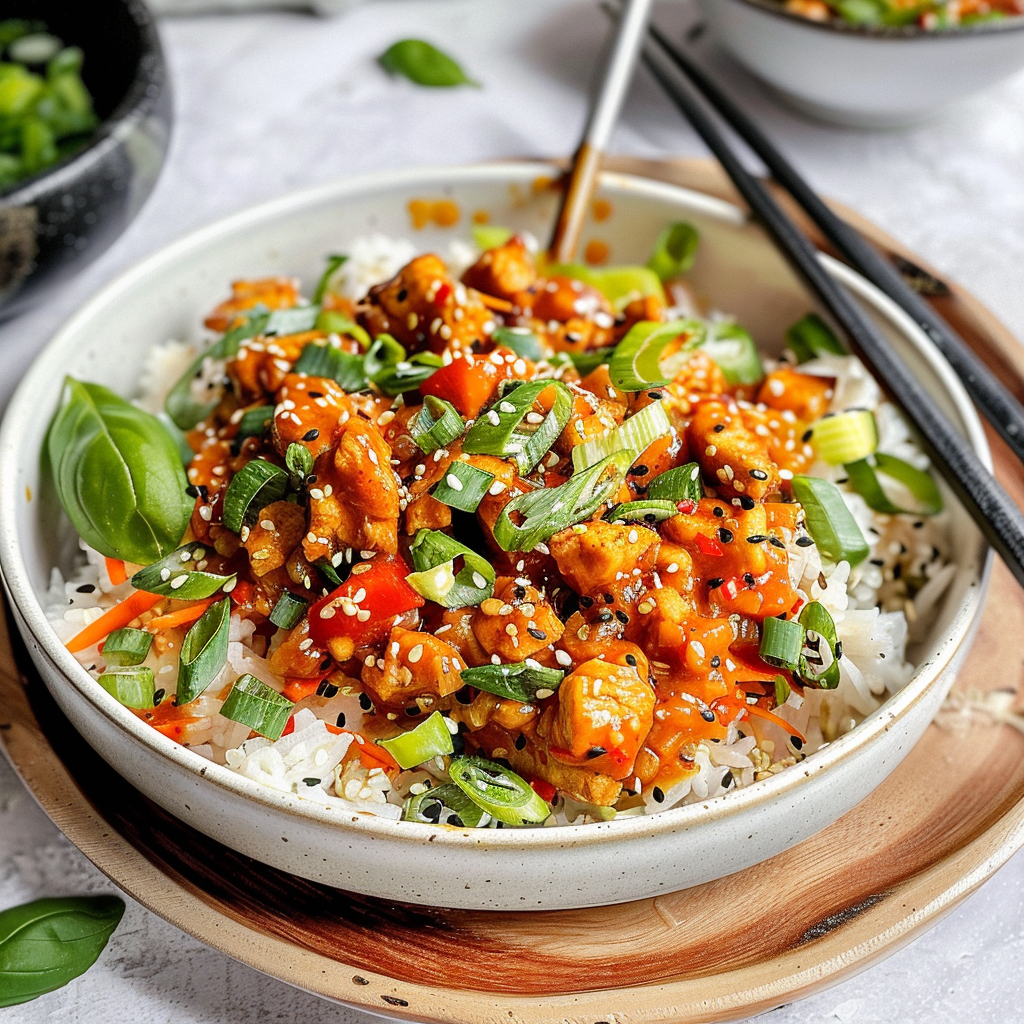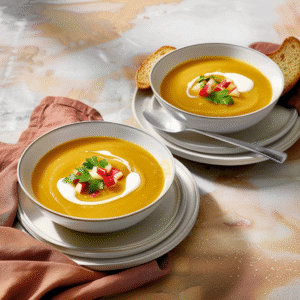The Gochujang Chicken Bowl is the culinary equivalent of a warm hug on a chilly day. Imagine tender chicken marinated in a spicy-sweet sauce that tickles your taste buds while also warming your soul. The vibrant colors and enticing aromas will make you feel like a gourmet chef, even if your cooking skills are more “microwave magician” than “culinary wizard.”

This dish is perfect for any occasion—family dinners, meal prep, or even just a cozy night in with your favorite show. The anticipation builds as you prepare this flavor-packed bowl; it’s not just dinner; it’s an experience that promises to delight everyone at the table.
Why You'll Love This Recipe
- This Gochujang Chicken Bowl is incredibly easy to whip up, making it a weeknight lifesaver.
- Its bold flavor profile has just the right kick, appealing to spice lovers and newbies alike.
- Visually stunning with bright colors, it’s sure to impress anyone who sees it.
- Plus, you can customize it with your favorite veggies or grains, making it versatile for any palate!
Ingredients for Gochujang Chicken Bowl
Here’s what you’ll need to make this delicious dish:
-
Boneless, Skinless Chicken Thighs: Thighs are juicier than breasts, ensuring your bowl stays flavorful and succulent.
-
Gochujang: This Korean chili paste brings a delightful sweetness and heat that adds depth to the dish.
-
Soy Sauce: Low-sodium soy sauce balances the flavors without overpowering the dish’s natural zest.
-
Honey: A touch of honey enhances the overall sweetness and helps caramelize the chicken while cooking.
-
Garlic: Fresh garlic cloves add aromatic depth; make sure they are minced finely for maximum flavor infusion.
-
Sesame Oil: This oil gives a nutty aroma and flavor that ties all the components together beautifully.
For the Toppings:
-
Sliced Green Onions: These provide a fresh crunch and bright color contrast to the rich chicken.
-
Sesame Seeds: Toasted sesame seeds add a delightful crunch and visual appeal to your finished bowl.
The full ingredients list, including measurements, is provided in the recipe card directly below.

How to Make Gochujang Chicken Bowl
Follow these simple steps to prepare this delicious dish:
Step 1: Marinate the Chicken
In a mixing bowl, combine gochujang, soy sauce, honey, minced garlic, and sesame oil. Add your chicken thighs to the mixture and ensure they are well-coated. Let them marinate for at least 30 minutes (or longer if you want those flavors to really sink in).
Step 2: Cook the Chicken
Heat a large skillet over medium-high heat. Remove excess marinade from the chicken thighs (we don’t want them swimming) and place them in the hot skillet. Cook for about 5-7 minutes on each side until they develop a nice golden-brown crust.
Step 3: Prepare Your Base
While the chicken cooks, prepare your base. You can use steamed rice or quinoa as a hearty foundation for this bowl. Cook according to package instructions.
Step 4: Slice and Serve
Once cooked through (internal temperature should reach at least 165°F or around 74°C), remove chicken from skillet and let it rest for a few minutes before slicing it into bite-sized pieces.
Step 5: Assemble Your Bowl
In each serving bowl, start with a scoop of rice or quinoa as your base. Arrange sliced chicken on top, then sprinkle with sliced green onions and toasted sesame seeds for that finishing touch.
Step 6: Drizzle Some Extra Sauce
If you’re feeling adventurous (and why wouldn’t you be?), drizzle some of that leftover marinade over everything before serving—just be sure it’s cooked first!
Transfer to plates and drizzle with sauce for the perfect finishing touch.
And there you have it—a delightful Gochujang Chicken Bowl that looks as good as it tastes! Enjoy every spicy bite while basking in compliments from family or friends gathered around your table. Don’t forget to relish those moments because let’s face it—food is not just about sustenance; it’s about connection!
You Must Know
- This Gochujang Chicken Bowl is a flavor explosion that makes dinner feel like a party.
- You can effortlessly adapt the ingredients to fit your pantry and preferences.
- The vibrant colors and delicious aromas will brighten any table, making it perfect for casual weeknights or special gatherings.
Perfecting the Cooking Process
Start by marinating the chicken in a rich blend of gochujang and other seasonings. While it soaks up all that goodness, prepare your rice and chop vegetables. Then, sear the chicken to golden perfection before tossing everything together for a delightful finish.
Add Your Touch
Feel free to swap the chicken for tofu or shrimp if you want a different protein. You can also play with additional toppings like avocado, sesame seeds, or even pickled vegetables to add extra flair and flavor to your Gochujang Chicken Bowl.
Storing & Reheating
Store leftovers in an airtight container in the fridge for up to three days. When reheating, add a splash of water or broth to keep everything moist and delicious while warming it on the stovetop or microwave.
Chef's Helpful Tips
- To achieve the best results, ensure your chicken is well-marinated for at least 30 minutes; this enhances flavor significantly.
- Always use high heat when searing to lock in juices and achieve that crispy texture.
- Lastly, let your bowl cool slightly before serving; this prevents sogginess from steam.
Sometimes, I whip up a Gochujang Chicken Bowl when I’m feeling adventurous. A friend once told me it was better than their favorite takeout—now that’s a compliment that warms my heart!
FAQs :
What is a Gochujang Chicken Bowl?
A Gochujang Chicken Bowl is a flavorful dish that combines marinated chicken with rice and fresh vegetables, all topped with a spicy, savory gochujang sauce. This Korean-inspired meal offers a balance of protein, carbs, and essential nutrients. It’s perfect for lunch or dinner, allowing you to enjoy a satisfying bowl packed with vibrant flavors. The gochujang adds depth and heat, making it a favorite among spicy food lovers. You can customize your bowl with various toppings to suit your taste preferences.
How do I make the Gochujang sauce?
To make the Gochujang sauce for your chicken bowl, you’ll need gochujang paste, soy sauce, honey, sesame oil, and garlic. Start by mixing these ingredients in a bowl until well combined. You can adjust the sweetness or spiciness based on your preference by adding more honey or gochujang. This sauce enhances the chicken’s flavor and brings all elements of the dish together. Drizzle it generously over your cooked chicken and vegetables for an authentic taste.
Can I make Gochujang Chicken Bowl ahead of time?
Yes, you can prepare the Gochujang Chicken Bowl ahead of time! Cook the chicken and rice in advance, then store them separately in airtight containers in the refrigerator. When you’re ready to eat, simply reheat the chicken and rice before assembling your bowl with fresh veggies and sauce. This makes it an excellent option for meal prep or quick dinners during busy weekdays. Just remember to add toppings like avocado or greens right before serving for optimal freshness.
What vegetables pair well with Gochujang Chicken Bowl?
Several vegetables complement the flavors of a Gochujang Chicken Bowl beautifully. Popular choices include cucumbers, carrots, bell peppers, and snap peas for crunch. You can also add leafy greens such as spinach or bok choy for added nutrition and texture. Feel free to experiment with seasonal produce to keep things interesting while ensuring each bowl remains colorful and healthy.
Conclusion for Gochujang Chicken Bowl :
The Gochujang Chicken Bowl is an exciting dish that beautifully combines tender marinated chicken with fluffy rice and vibrant vegetables. Its signature gochujang sauce adds a unique flavor profile that makes this meal irresistible. Whether you’re preparing it for a quick weeknight dinner or meal prepping for the week ahead, this recipe offers versatility and deliciousness in every bite. Remember to customize your bowl with fresh toppings to enhance both texture and flavor while enjoying this delightful Korean-inspired creation!
Gochujang Chicken Bowl
Gochujang Chicken Bowl is a vibrant, flavor-packed dish that combines tender marinated chicken with a spicy-sweet gochujang sauce, served over a fluffy base of rice or quinoa. Topped with fresh veggies and garnished with green onions and sesame seeds, this bowl is perfect for family dinners or cozy nights in. With its enticing aromas and colorful presentation, it promises to warm your heart and delight your taste buds.
- Prep Time: 30 minutes
- Cook Time: 15 minutes
- Total Time: 45 minutes
- Yield: Serves 4
- Category: Main
- Method: Cooking
- Cuisine: Korean
Ingredients
- 1 lb boneless, skinless chicken thighs
- 3 tbsp gochujang
- 2 tbsp low-sodium soy sauce
- 1 tbsp honey
- 3 cloves garlic, minced
- 1 tbsp sesame oil
- 2 cups cooked rice or quinoa (for serving)
- 2 green onions, sliced (for topping)
- 1 tbsp toasted sesame seeds (for topping)
Instructions
- 1. Marinate the Chicken: In a bowl, combine gochujang, soy sauce, honey, minced garlic, and sesame oil. Add chicken thighs and coat well. Marinate for at least 30 minutes.
- 2. Cook the Chicken: Heat a skillet over medium-high heat. Remove excess marinade from the chicken and cook for 5-7 minutes on each side until golden brown and cooked through.
- 3. Prepare Your Base: While the chicken cooks, prepare rice or quinoa according to package instructions.
- 4. Assemble Your Bowl: Slice the cooked chicken and place it over rice or quinoa. Top with sliced green onions and toasted sesame seeds.
- 5. Drizzle Sauce: Optionally drizzle any leftover marinade over the bowl before serving.
Nutrition
- Serving Size: 1 bowl (approximately 300g)
- Calories: 450
- Sugar: 6g
- Sodium: 600mg
- Fat: 18g
- Saturated Fat: 4g
- Unsaturated Fat: 12g
- Trans Fat: 0g
- Carbohydrates: 48g
- Fiber: 2g
- Protein: 30g
- Cholesterol: 120mg
Keywords: - For added variety, swap chicken for tofu or shrimp. - Experiment with toppings such as avocado or pickled vegetables to elevate flavor. - Leftovers can be stored in an airtight container for up to three days; reheat with a splash of water to maintain moisture.







